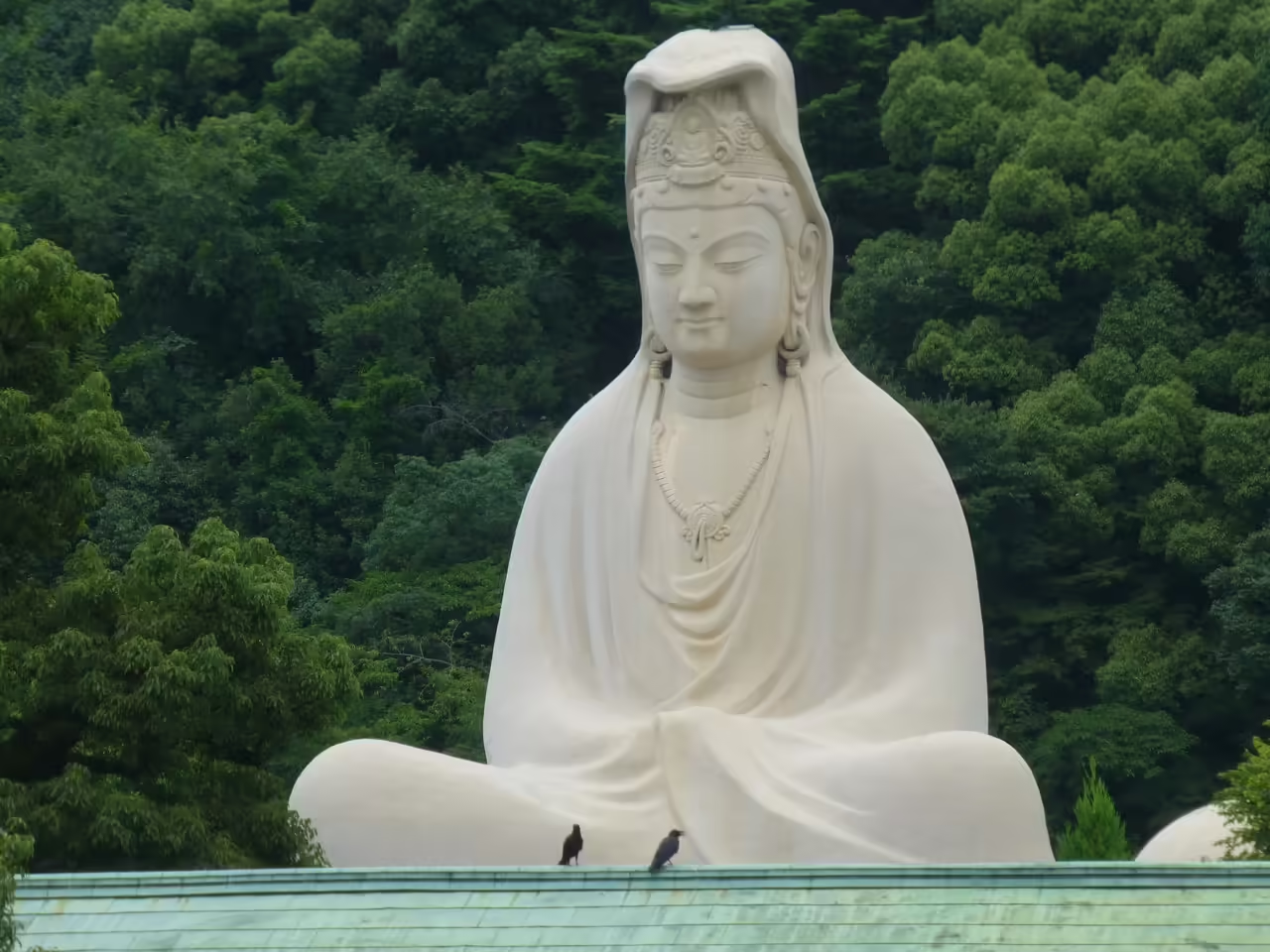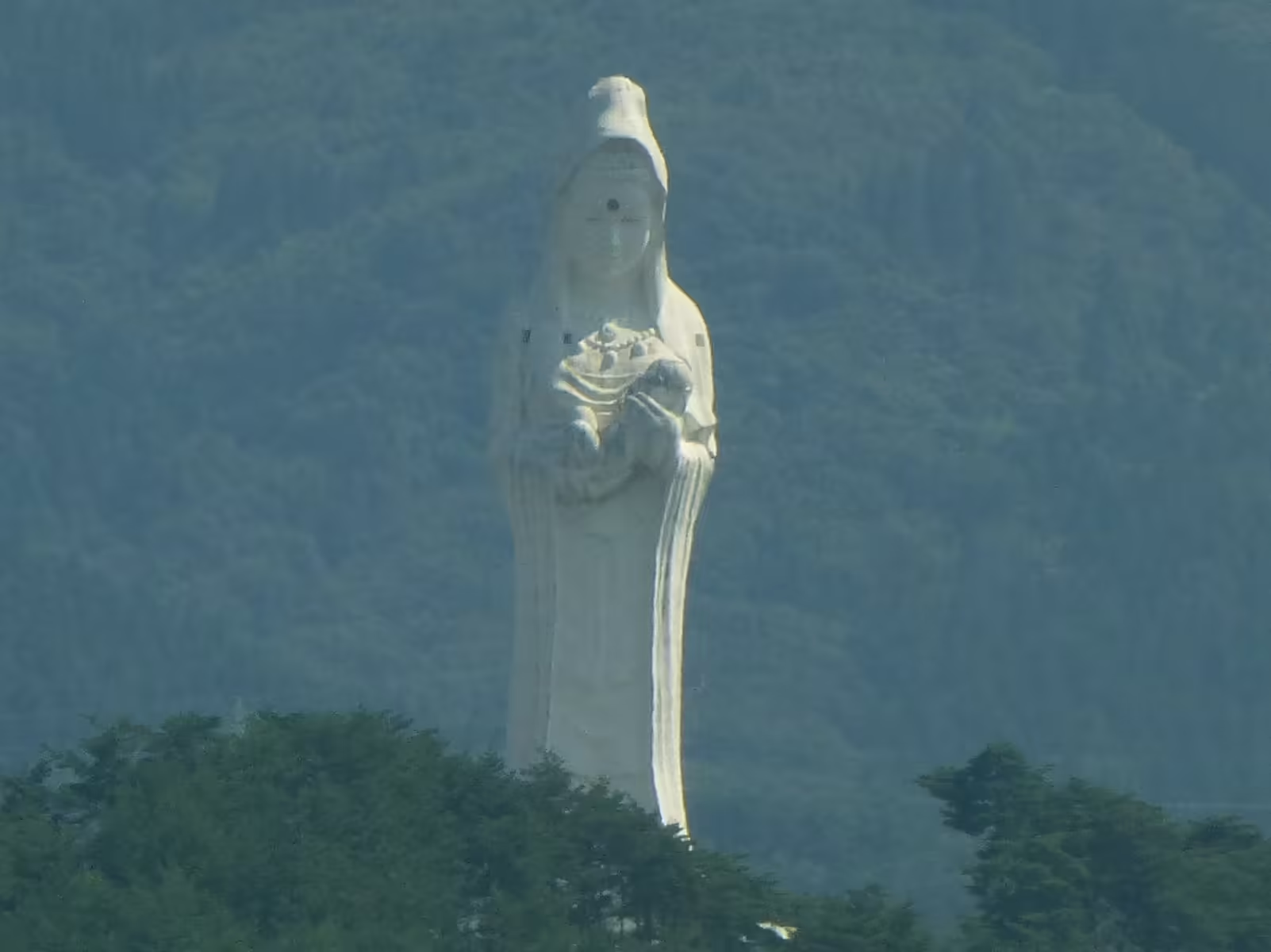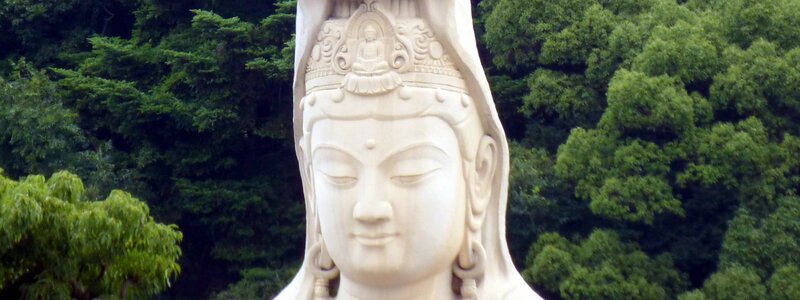Some time ago I stumbled across an intriguing random fact: of the fifty tallest statues in the world, fourteen are of the Buddha but eighteen are of a being called Kannon in Japanese (Guanyin in Chinese). Thirteen of these tallest statues are in Japan and twelve of these are Kannon statues (the other is a statue of the Buddha).
So who is this Kannon, and why are some many of the tall statues of it, in particular in Japan?
First of all, there is little mystery in the tall statues themselves. They are almost invariably built either as tourist attractions or as war memorials. What is more interesting though is why so many of them represent the Kannon.
Buddha and Bodhisattva
Buddhism originated in India sometime between the sixth and fourth century BCE, and spread to Japan via China in the first half of the sixth century CE. By that time, it had already developed a long tradition and forked into several branches. There are three major schools of Buddhism: Theravada, Mahāyāna, and Vajrayana.
In general in Buddhism, a bodhisattva (a sentient being, sattva , that develops enlightenment, bodhi) is any person who is on the path towards Buddhahood. Specifically in Mahāyāna Buddhism, a bodhisattva refers to anyone who has developed a mind that strives toward awakening (attaining Buddhahood), empathy, and compassion for the benefit of all sentient beings. (This is known as bodhicitta.)
Kannon
In Japanese, bodhisattva are know as bosatsu (菩薩). One bosatsu that is especially popular is Kannon (観音). The word is a contraction of Kanzeon (観世音), which in its turn is the most commonly used translation of the bodhisattva known in Sanskrit as Avalokiteśvara. Kannon is the bodhisattva associated with compassion. The name means “[The One Who] Perceives (観) the Sounds (音) of the World (世).”
The Sanskrit term was originally Avalokitasvara with the ending svara (“sound, noise”), which means “sound perceiver”, literally “he who looks down upon sound” (i.e., the cries of sentient beings who need his help). Over time, the name changed to Avalokiteśvara. The ending īśvara means “lord”, so the meaning became “lord who gazes down (at the world)”, but kannon retains the original meaning.
This bodhisattva is also referred to as Padmapāṇi (“Holder of the Lotus”) or Lokeśvara (“Lord of the World”). In Tibetan, Avalokiteśvara is known as Chenrézig and the Dalai Lama is considered the reincarnation of Chenrézig.
In summary, Kannon is the bodhisattva of infinite compassion who gazes down at the human world, hears all the cries of suffering, and works tirelessly to help those who call upon its name.
The gender of Kannon is rather vague (I will explain that below) so in what follows I will use the pronouns “they/them” to refer to Kannon.
Buddhism in Japan
Outside of Japan, Japanese Buddhism is usually associated with Zen Buddhism, but there are many different Buddhist sects in Japan, and Zen sects are actually a minority. This Tofugu article gives a good overview. The dominant form of Buddhism in Japan is Mahāyāna: of the main thirteen sects, eleven are Mahāyāna, including the three Zen sects; only the Ritsu (Theravāda) and Shingon (Vajrayana) sects are not Mahāyāna.
In Mahāyāna (and Vajrayana) Buddhism, several Buddhas are venerated that are not found in early Buddhism or in Theravada Buddhism. They are considered to be living in other realms, known as “Pure Lands” (Jōdo 浄土), and are sometimes called “celestial Buddhas” as they are not of this earth.
The most important of these is Amitābha (Amida 阿弥陀, “Buddha of Infinite Light”). This is the principal deity of worship for the Pure Land Buddhist sect and sects that derive from this tradition. Kannon is a spiritual emanation of Amida Buddha and therefore occupies a major place in the pantheon.
Kannon is mentioned in numerous Mahāyāna sutra (religious texts), but especially in Chapter 25 of the Lotus Sutra (Hokekyō 法華経). Because they are the bodhisattva of of infinite compassion, they became the favourite deity. Today, Kannon worship is very widespread and essentially non-denominational. Their statues are everywhere, and there are hundreds of pilgrimage routes.
Gender
The Lotus Sutra describes Avalokiteśvara (Kannon) as a bodhisattva who can take the form of any type of god, any type of Buddha, as well as any gender, adult or child, human or non-human being, in order to teach the Dharma to sentient beings.
Avalokiteśvara was originally depicted as a male bodhisattva and sometimes even has a light moustache. Although this depiction still exists, in modern times Kannon is more often depicted as a woman or as an androgynous figure. According to the doctrines of the Mahāyāna sūtras themselves, it does not matter whether Kannon is male, female, or genderless, as the ultimate reality is in emptiness (kū 空, śūnyatā).
Manifestations
A total of 33 different manifestations of Kannon are described in Chapter 25 of the Lotus Sutra depending on whatever a living being needs to be saved. One might think that 33 different forms would be plenty. However, when we look at the Kannon statues, we find that some are indeed part of these 33:
- The Byakue Kannon (白衣観音, White-robed Kannon), “A persistent femininity clings to this kannon even though the figure is shown as a male.”

The Ryōzen Kannon 霊山観音 of Kyoto, a Byakue Kannon. -
Guze (救世 , salvation or Shou 聖, holy), a male Kannon. The most famous Guze Kannon statue can be found in the Hōryū-ji Temple (法隆寺) in Nara. It was made in the image of prince Shōtoku Taishi (聖徳太子), the first great patron of Buddhism in Japan, in the early 7th Century. Many statues are copies of this one.
- Gyouran (魚籃, Kannon carrying a fish basket), a female Kannon. There is an interesting story about this kannon (and the same story as a comic) and another nice one.
But there are also some that are not part of the 33 canonical ones:
- Jibō Kannon (慈母, loving mother), a female Kannon holding a baby, patron of motherhood ans children (koyasu 子安), and both protect the souls of aborted or stillborn children (mizuko 水子). Despite not being in the canon, this is a very popular Kannon.

The Jibō Daikannon of Aizu. -
Heiwa Kannon (平和 eternal piece), usually male or androgynous, to to pray for world peace and commemorate the war dead. Most of these were built in the 1950s but an interesting example from 1997 is the Awaji Heiwa Kannon. Some of the Kannon dedicated to world piece are Byakue, like the Ryōzen Kannon above and the Ofuna Kannon in Kamakura.
- Maria Kannon (マリア観音, Virgin Mary), a female Kannon. Christianity was banned in Japan during the Tokugawa Era (1615-1867). In the 17th century, the Japanese crypto-Christians created statues of the Virgin Mary disguised as Kannon. These effigies, called Maria Kannon, looked like Jibō Kannon but they were venerated by the Christians silently praying to Mother Mary. Many of the statues had a Christian icon hidden inside the body or in the artwork.
References
I consulted many references for this post but these are the most noteworthy:
- “List of tallest statues”, Wikipedia page
- 「巨大仏」Wikipedia page on large Buddha and Kannon statues, in Japanese
- “Three different paths: Theravada, Mahāyāna, and Vajrayana”, Lama Tsomo
- “The Real Japanese Monk’s Guide To Buddhism In Japan”, Mami Suzuki
- “Kannon Notebook”, Mark Schumacher
- “The unfortunate history of the “Whiplash Kannon” and Heiwakannon-ji”, Austin Smith
- “Byakue Kannon 白衣観音”, Japanese Architecture and Art Net Users System
- “Kannon: Figure of the Bodhisattva in Japanese Buddhism “, Steven Gump
- “The Lotus Sutra”
- “The Buddhist Legend Of The Fish Basket”
- “The Origin Of Fish Basket Holding Guan Yin” (comic) )
- “The Fish Basket Goddess: A Tale from Ancient China”.
The banner picture is a detail of the Ryozen Kannon (霊山観音) in Kyoto.
